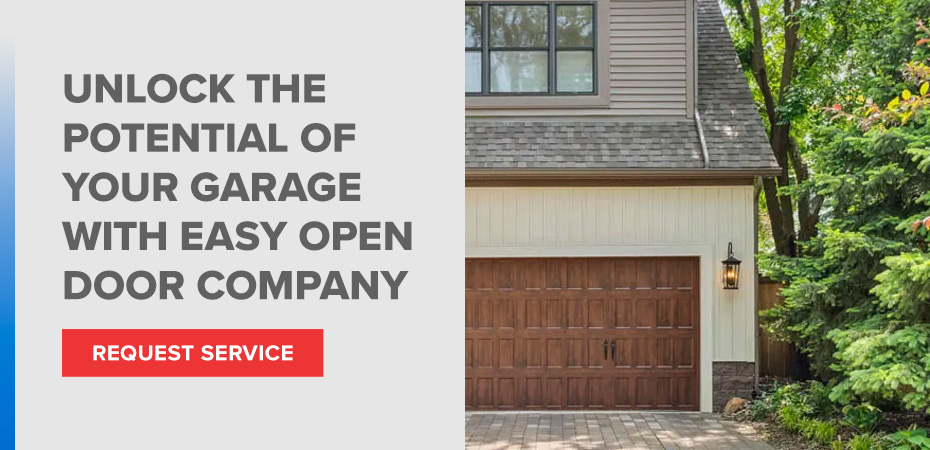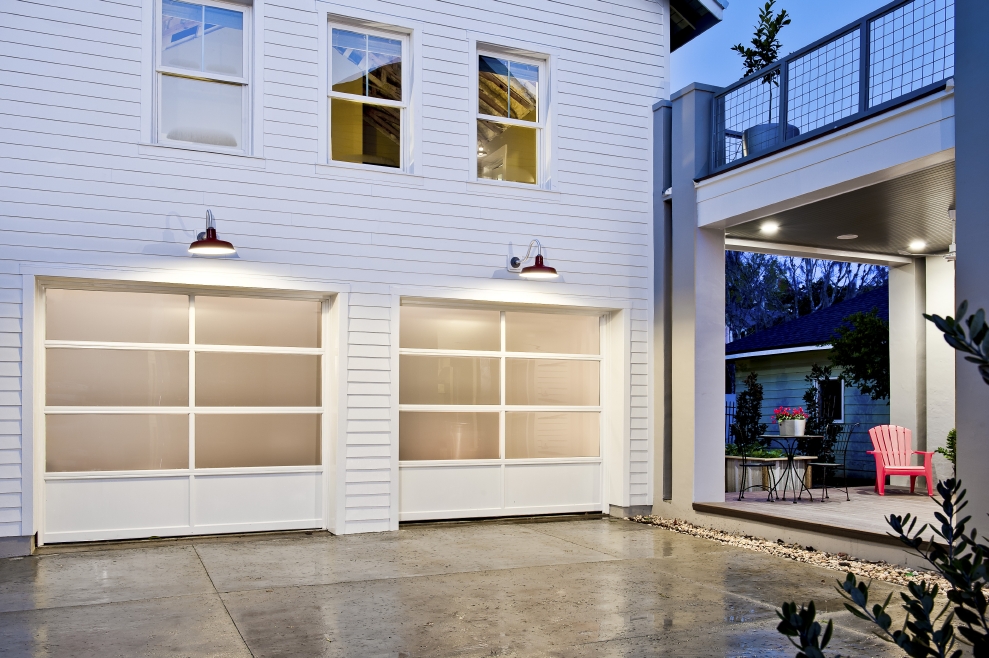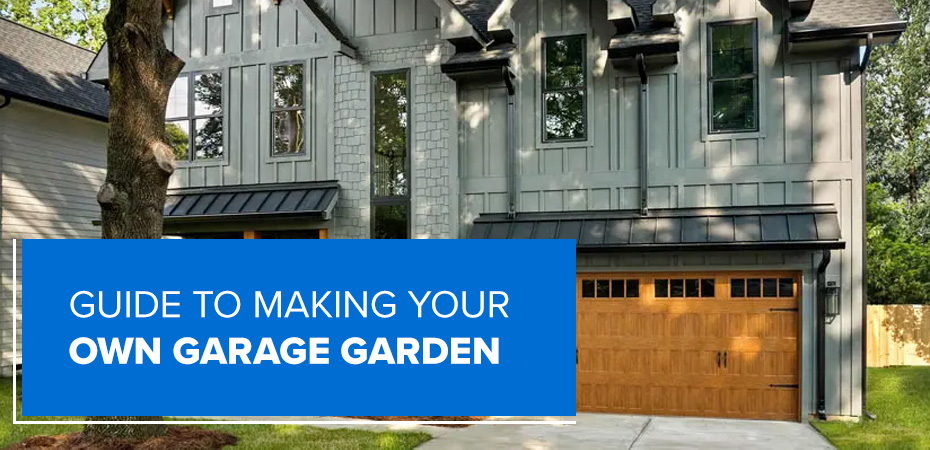
The rise in home gardening has inspired various indoor gardens, from the kitchen to the garage. Having a garden in a garage is an innovative way to extend your growing space and enjoy fresh produce year-round. With the right setup and knowledge, you can transform your garage into a thriving oasis of plants.
This comprehensive guide will help you create your own growing space, providing valuable garage garden ideas, step-by-step instructions and tips for success. Whether you’re an experienced gardener or just starting out, this article will help you turn your garage and garden dreams into a reality.
Table of Contents
Materials Needed for a Garage Garden
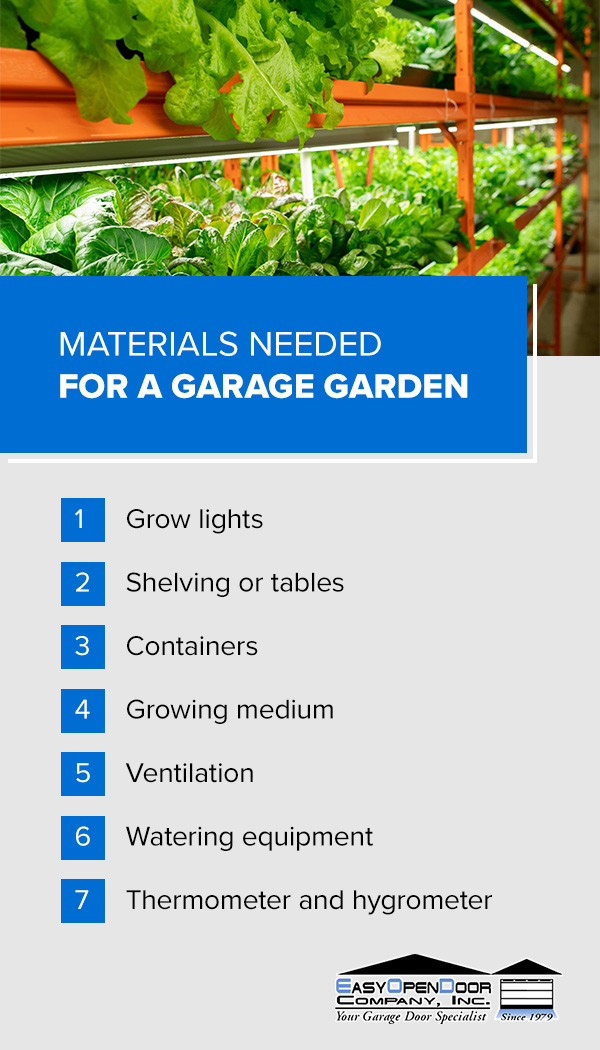
Before you can begin garage gardening, it’s essential to gather all the necessary materials. Here’s what you’ll need:
- Grow lights: Adequate lighting is critical for your garage plans. Invest in high-quality LED grow lights that provide the optimal spectrum for plant growth.
- Shelving or tables: Choose sturdy shelving units or tables to support your plants and maximize vertical space.
- Containers: Select appropriate plant containers, such as pots, trays or grow bags, and ensure proper drainage.
- Growing medium: Depending on your setup, you’ll need soil, soilless mix or a hydroponic system with a growing medium like coco coir or perlite.
- Ventilation: Proper air circulation is vital for plant health. Install fans or vents to regulate temperature and humidity.
- Watering equipment: To keep your plants well-hydrated, invest in a watering can, hose or automatic irrigation system.
- Thermometer and hygrometer: Monitor your garage’s temperature and humidity levels to ensure optimal growing conditions.
How to Make Your Own Garage Garden
Once you have gathered all the necessary materials, it’s time to set up your garage garden. Here’s a step-by-step guide to making a garage garden a functional and efficient growing space.
1. Clean and Prepare Your Garage
The first step in setting up your garage garden is thoroughly cleaning and preparing the space. Remove clutter, debris and items that may interfere with your gardening activities. Sweep the floor and wipe down surfaces to create a clean, organized environment.
Inspect your garage for pest infestations, such as rodents or insects. Address them before setting up your garage garden to prevent damage to our plants. Seal any cracks or gaps in the walls or foundation to prevent pests from entering and to maintain a consistent temperature.
Ensure your garage is well-insulated to protect your plants from extreme temperature fluctuations. Check the insulation in the walls, ceiling and garage doors. If necessary, add more insulation or weather stripping to improve energy efficiency and create a more stable growing environment.
2. Install Grow Lights
Proper lighting ensures a successful garden. Install your grow lights securely above the shelving or tables where you’ll place your garage plants. Use chains, cables or study hooks to suspend the lights at the appropriate height. Adjust the height of the lights as your plants grow to maintain the optimal distance for proper light intensity.
3. Set Up Shelving or Tables
Arrange your shelving units or tables to maximize space and allow easy access to your plants. When planning the placement of shelves and tables, consider your garage’s layout and the available space.
If using adjustable shelves, configure them to accommodate plants of different heights. Ensure your shelving or tables are level and stable to prevent accidents or damage to your plants. Use shims or adjustable feet to level the surfaces if necessary. Secure the shelves or tables to the wall or floor to prevent tipping or movement.
4. Choose Your Growing Medium
Your growing medium depends on your preferred gardening method and the types of plants you want to grow. For soil-based setups, fill your containers with a high-quality potting mix that provides excellent drainage and aeration. If you opt for soil-less mediums, look for mixes that contain ingredients like perlite, vermiculite or coconut coir to improve soil structure and moisture retention.
If you opt for a hydroponic system, research the best-growing medium for your setup. Popular aggregate substrates include coco coir, perlite and rockwool. These support the plant roots while allowing for efficient water and nutrient delivery.
5. Install Ventilation
Place fans strategically throughout your garage to promote air circulation and prevent stagnant air pockets. Oscillating fans are a fantastic option for even air distribution.
Consider installing exhaust fans to help regulate temperature and humidity levels. Mount exhaust fans on walls or the ceiling to draw out warm, humid air and bring in fresh air from outside. The air exchange prevents excess moisture buildup and reduces the risk of mold and mildew growth.
6. Set Up Watering System
Based on the size of your setup and the types of plants you are growing, determine the most suitable watering method for your garage garden. For smaller setups, a watering can with a narrow spout or a hose with a spray nozzle can be sufficient. These manual methods allow for precise watering and can be based on the needs of individual plants.
For larger gardens or to save time and effort, invest in an automatic drip irrigation system. Drip irrigation delivers water directly to the base of the plants, reducing water waste and ensuring consistent moisture levels. You can set up a timer to automate the watering schedule based on each plant’s specific requirements.
Best Plants for Garage Gardening
When selecting plants for your garden, consider those that thrive in the unique growing conditions of an indoor environment. Some of the best plants for garage gardening include the following.
Leafy Greens
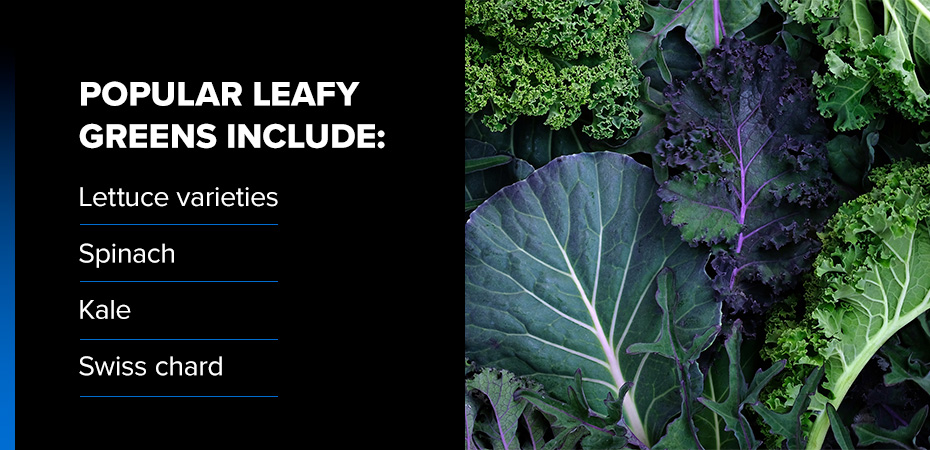
Leafy greens are excellent garage plants due to their fast growth, compact size and versatility in the kitchen. Some popular leafy greens include:
- Lettuce varieties such as loose-leaf, butterhead and romaine are fast-growing and can be harvested continually.
- Spinach is a nutrient-dense leafy green that thrives in cooler temperatures, making it perfect for garage gardening.
- Kale is hardy, resilient, can withstand temperature fluctuations and requires minimal space.
- Swiss chard is a colorful and flavorful leafy green that adds visual appeal to your garden and can be harvested continuously.
Leafy greens can be grown in containers or hydroponic systems, allowing for efficient use of space and easy harvesting. They require moderate light levels and consistent moisture to thrive.
Herbs
Herbs are an excellent choice, particularly when growing plants in the garage during winter. They add flavor to your dishes and can offer medicinal benefits. They can be grown in small containers or hanging baskets to maximize space or grouped in large pots. However, they require well-draining soil and moderate watering to prevent root rot.
Some herbs for garage gardening include basil, cilantro, parsley and chives.
Microgreens
Microgreens are young, tender seedlings harvested within one to two weeks of germination. They are packed with nutrients and offer intense flavors in a compact form, making them perfect for gardening. The following are some of the most popular microgreens used as garage plants:
- Radish
- Broccoli
- Sunflower
- Pea shoots
Microgreens can be grown in shallow trays or containers with a thin layer of growing medium. They require minimal space and can be harvested quickly, allowing for a continuous supply of fresh, nutritious greens — even in winter.
Dwarf Fruit Trees
For those with a larger garage space, dwarf fruit trees can be a rewarding addition to a garden. These compact trees are grafted onto dwarfing rootstocks, limiting their size while producing a bountiful harvest.
Dwarf fruit trees you can include in your garage garden include lemon, lime and orange. These trees can be grown in large containers with a well-draining potting mix. They require regular pruning to maintain their compact size and promote fruiting. Provide adequate light and monitor moisture levels to ensure healthy growth.
6 Tips for Maximizing Your Garage Garden
To get the most out of your garage garden, consider implementing these tips and techniques to optimize plant growth and maximize your harvest.
1. Optimize Lighting
Proper lighting is essential for the healthy growth and development of your plants, especially when growing plants in the garage during winter. Follow these tips to optimize lighting in your garage garden:
- Use a timer to automate the lighting schedule and ensure your plants receive the appropriate amount of light each day.
- Consider using reflective materials, such as mylar or white paint, on the walls and ceiling of your garage to maximize light distribution and efficiency.
2. Control Temperature and Humidity
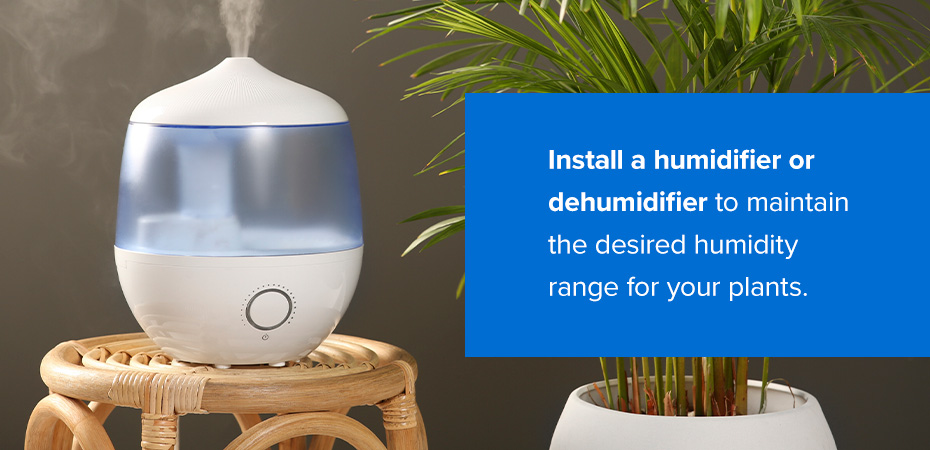
Maintaining consistent temperature and humidity levels is crucial for the health and productivity of your plants. In addition to fans and vents for air circulation, install a humidifier or dehumidifier to maintain the desired humidity range for your plants.
Monitor temperature and humidity levels regularly with a thermometer and hygrometer. Adjust your ventilation and climate control systems as needed to maintain optimal growing conditions.
3. Implement Efficient Watering Techniques
Proper watering ensures garage plant health and growth. Water your plants consistently, making sure the growing medium remains evenly moist but not soggy. Before watering, stick your finger into the soil or use a moisture meter to assess moisture levels.
Consider switching to drip irrigation or self-watering containers to provide a steady water supply to your plants. These methods help conserve water and reduce the risk of overwatering. You can also collect and reuse water from air conditioner condensation or dehumidifiers to supplement your watering needs and conserve.
4. Provide Proper Plant Nutrition
Feeding your plants with the appropriate nutrients is essential for healthy growth and development. Use a balanced nutrient solution or fertilizer specifically formulated for your growing plants. Follow the manufacturer’s instructions for application rates and frequency.
Use organic fertilizers, such as compost tea or fish emulsion, to provide your plants with a natural source of nutrients. These options can improve soil health and promote beneficial microbial activity. Monitor your garage plants for signs of nutrient deficiencies, such as yellowing leaves or stunted growth. Adjust your fertilization regimen accordingly to address any issues.
5. Practice Companion Planting
Companion planting involves grouping plants with complementary growth habits and benefits. Place plants with similar growing requirements together to simplify care and maintenance. For example, herbs with matching light and water needs should be placed in the same container.
Plant beneficial companion plants that deter pests or attract pollinators. For instance, planting basil near tomatoes can help repel aphids, while planting marigolds can attract beneficial insects. To provide natural shade for lower-growing plants, utilize vertical space by planting climbing plants, such as peas or pole beans, alongside taller plants, like tomatoes or peppers.
6. Expand Your Garage Garden
As you gain experience and confidence in garage gardening, you can expand your setup to include various plants and growing methods. Incorporate vertical gardening techniques, such as using trellises, hanging baskets or wall-mounted planters, to maximize space and add visual interest to your setup.
Experiment with different growing methods, such as hydroponics or aquaponics, to diversify your plant selection and explore new ways of growing food indoors. Add supplemental lighting, such as high-pressure sodium lamps, to increase light intensity and promote faster growth. Expand your plant selection to include exotic or specialty crops, such as heirloom varieties or rare herbs, to add excitement and variety to your harvest.
Frequently Asked Questions About Garage Gardens
Explore some of the most common questions homeowners have about creating a garage garden below.
How Do I Balance Natural and Artificial Lights When I Garden in the Garage?
If your garage has windows that allow natural light, you can supplement it with artificial grow lights. Monitor the intensity and duration of natural light and adjust your artificial lighting accordingly.
What Is the Ideal Temperature for Indoor Plants?
The types of plants you are growing will impact what temperatures are best for growth. In general, avoid extreme temperature fluctuations and protect your plants from cold drafts or excessive heat.
Can I Turn My Garage Into a Greenhouse?
Yes, you can convert your garage into a greenhouse-like environment. Install proper insulation, ventilation and climate control systems to create more stable growing conditions for your plants.
What Is a Good Heat Source for a Garage Garden?
If your garage tends to get chilly, you can use space heaters, heating mats or radiant heating panels to provide additional warmth for your plants. Be sure to monitor the temperature closely and keep the heat source at a safe distance.
Unlock the Potential of Your Garage With Easy Open Door Company
Making your own garage garden is a rewarding and fulfilling endeavor that allows you to enjoy fresh produce year-round. By following the steps in this guide and implementing the tips provided, you’ll create a thriving indoor garden.
Before you start gardening, ensure your garage is in top working condition. With 39 years of experience, Easy Open Door Company is the ideal company for garage door installation, repair and maintenance. We offer high-quality garage doors, custom wood doors, and LiftMaster garage door openers in San Diego County, California. With Easy Open Door Company, you can have peace of mind knowing your garage is secure and functional, allowing you to focus on nurturing your garden.
Contact us today for a free estimate or more information.
